HISTORICAL BACKGROUND
Pre-modern hominid populations migrated to France during Paleolithic times, and between 30,000 and 10,000 years ago, modern humans left evidence of their presence in cave art. After 600 B.C. Greek and Phoenician traders operated along the French Mediterranean coast, while Celts migrated westward from the Rhine valley, settling the territory later called Gaul by the Romans. The Romans under Julius Caesar conquered part of Gaul in 57–52 B.C., and it remained Roman until the Western Roman Empire disintegrated into small-scale agrarian settlements as the Franks invaded in the fifth century A.D. An interval of territorial consolidation occurred in the eighth century under the Frankish King Charlemagne, who took the title of Holy Roman Emperor. After his death, his three grandsons divided his empire among themselves and held territories corresponding roughly to France, Germany, and Italy. These territories became increasingly feudalized, with rule by numerous local lords. Vikings or “Northmen” raided coastal settlements, colonized Normandy, a territory named after them, and in 1066 conquered England, installing Duke William⎯William the Conqueror⎯as King of England. In the meantime, from 987 and for the next 350 years, an unbroken line of Capetian kings added to their domain, the region surrounding Paris known as the Île-de-France. As royal power gained ground against the feudal lords, the great monastic orders and emerging towns fueled an economic and cultural flowering. By 1328 and the accession of Philip VI, the first of the Valois kings, France boasted the highest achievements of medieval European culture⎯its Romanesque and Gothic architecture⎯and was the most powerful nation in Europe, with a population of 15 million. This population, like others in Europe, suffered a demographic disaster after 1348, when the Black Death (bubonic plague) entered France through Marseille and killed as many as one-third of the country’s inhabitants.
A decade before the Black Death struck, disputed territorial and dynastic claims between France and England led to the Hundred Years’ War (1337–1453) in France. When the French eventually won, with the help of the young Joan of Arc, the English retained no French possessions except Calais. The Valois dynasty’s holdings came to resemble modern France, once Burgundy and Brittany were added. After the 1540s, the Protestantism of John Calvin spread throughout France and led to civil wars. The Edict of Nantes (1598), issued by Henry IV of the Bourbon dynasty, sustained Catholicism as the established religion of France but granted religious tolerance to the French Protestants (Huguenots) and calmed religious conflict. Absolute monarchy reached its apogee in the reign of Louis XIV (1643–1715), the Sun King, who built the Palace of Versailles, a celebration of French art and architecture.
The ambitious projects and military campaigns of Louis and his successors led to chronic financial problems in the eighteenth century. Deteriorating economic conditions and popular resentment against the system of privileges and tax exemptions enjoyed by the nobility and clergy were among the principal causes of the French Revolution (1789–94). The Revolution ended unchecked monarchical rule, enhanced the power of non-noble elites, and brought more equitable land distribution to the peasantry. French revolutionary ideals⎯especially ideals of nationhood and universal rights⎯long proved a powerful influence on the development of national movements elsewhere in the world. However, France’s own first experiment in republican and egalitarian government fell into turmoil, culminating in the “Reign of Terror.” France reverted to forms of dictatorship or constitutional monarchy on four occasions in the nineteenth century⎯the Empire of Napoléon Bonaparte (1804–14, and three-month restoration, 1815), the Bourbon Restoration (1814–30), the reign of Louis-Philippe (1830–48), and the Second Empire of Napoléon III (1852–70). Under Napoléon Bonaparte, France extended its rule and cultural influence over most of Europe before suffering defeat at Waterloo in 1815. Another defeat a half century later, in the Franco-Prussian War (1870), ended the rule of Napoléon III and ushered in the Third Republic, which lasted until France’s military defeat at the hands of Nazi Germany in 1940. Throughout these changes in the political landscape, France remained among the world’s leaders in industrialization, science and technology, and eventually labor and social legislation. France was also a major participant in Europe’s colonial expansion, second only to Britain in the extent of its empire in Africa, the Middle East, and the Far East. Finally, France remained a magnet for generations of avant-garde artists and writers.
Although on the victorious side in World War I, France bore the brunt of the war’s huge human and material losses and emerged at the end of 1918 determined to keep Germany weak through systems of alliances and defenses. Despite these, France was defeated by Nazi Germany early in World War II. In 1940 Nazi troops marched into an undefended Paris, and Marshal Henri Philippe Pétain signed an armistice. France was divided into an occupied north and an unoccupied south, Vichy France, which became a German puppet state with Pétain as its head. Vichy France acquiesced in the plunder of French resources and the deportation of forced labor and Jews to Germany. After four years, Allied armies liberated France in August 1944, and a provisional government was established, headed by General Charles de Gaulle, the wartime leader of Free France. In 1946 de Gaulle resigned, and a new constitution set up the Fourth Republic, featuring a parliamentary form of government controlled by a series of party coalitions. Under this governmental arrangement, France took important steps in promoting international cooperation, when it joined the North Atlantic Treaty Organization (NATO) and spearheaded European integration. In 1951, in a dramatic reconciliation, France and Germany, along with four other countries, founded the European Coal and Steel Community. It featured a joint administration, parliament, and supreme court, institutions that still govern today’s European Union (EU). In 1957 France and the same five countries created a broader economic bloc, the European Economic Community, or Common Market, when they acceded to the Treaty of Rome, the core agreement of the EU.
Notwithstanding its accomplishments, the French government was prone to cabinet crises and proved inadequate to the challenge of the independence struggles of the country’s colonies in French Indochina, or present-day Vietnam (1945–54), and Algeria (1954–62). France’s war against communist insurgents in Indochina was abandoned after the defeat of French forces at Dien Bien Phu in 1954. A revolt in Algeria proved so divisive in France as to threaten a military coup there, prompting the National Assembly in 1958 to invite de Gaulle to return as premier with extraordinary powers. Under the new Gaullist constitution for a Fifth Republic, which strengthened the presidency and reduced legislative power, he was elected president in December 1958. Under de Gaulle, the dissolution of France’s overseas empire continued. The French protectorates of Morocco and Tunisia had received independence in 1956. In 1960 French West Africa was partitioned, and the new nations were granted independence. Algeria, after a long civil war, finally became independent in 1962. Many of the former colonies maintained close economic and cultural ties with France.
In an example of France’s occasionally maverick foreign policy, de Gaulle took France out of the NATO military command in 1967 and expelled all foreign-controlled troops from the country. De Gaulle’s government was weakened by massive protests in May 1968 when student rallies merged with wildcat strikes by millions of factory workers across France. The movement aimed at transforming the authoritarian, elitist French system of governance and came close to forcing de Gaulle from power. After order was reestablished in 1969, de Gaulle resigned and his successor, Georges Pompidou (1969–74), modified Gaullist policies to include a stronger market orientation in domestic economic affairs. Valéry Giscard d’Estaing, elected president in 1974, also supported conservative, pro-business policies.
Socialist François Mitterrand was elected president in 1981, beginning a record 14-year tenure in that office. He saw seven prime ministers and two periods of “cohabitation” (1986–88 and 1993– 95) in which the prime minister was from the center-right opposition. He also saw France’s first female prime minister, Edith Cresson (1991–92). Early in the Mitterrand presidency, the victorious socialists, carrying out their campaign pledges, imposed a wealth tax, nationalized key industries, decreed a 39-hour workweek and five-week paid vacations, halted nuclear testing, suspended nuclear power plant construction, and abolished the death penalty. The most notable and lasting achievements of the Mitterrand presidency, however, came in the international arena, where France’s major commitment remained the European Economic Community and, especially, improved Franco-German relations, regarded as the key to Europe’s integration. Under Mitterrand, after decades of ups and downs, the Common Market got a boost from the 1986 Single European Act, which eased the free movement of goods and labor. A capstone accomplishment came in the 1992 Treaty of Maastricht, which established a common currency and created the EU to coordinate foreign policy and immigration as well as economics. In promoting the treaty and monetary union, Mitterrand worked well with Germany’s Chancellor Helmut Kohl, strengthening Franco-German economic and security ties.
France continued to be a driving force behind the EU’s progress and expansion under the centerright Gaullist Jacques Chirac, who won the presidency in 1995 on a platform of reducing France’s chronically high unemployment. Chirac briefly resumed France’s nuclear testing in the South Pacific, despite widespread international protests. During his five years of cohabitation (1997–2002) with a socialist legislative majority, the euro was introduced (2002) and the franc retired as legal tender. In 1999 France took part in the NATO airstrikes in Kosovo, despite some internal opposition. In the 2002 election season, Jean-Marie Le Pen, leader of the neo-fascist, anti-immigrant National Front party, shocked France with his strong performance, a secondplace finish in the first round of voting. He took 17 percent of the vote, handing a humiliating defeat to Lionel Jospin, the Socialist prime minister, whose party threw its support behind the incumbent Chirac and bolstered his overwhelming victory of 82 percent in the runoff election.
In 2003, in Chirac’s second term, France defied the United States and the United Kingdom in the run-up to the Iraq War by calling for more weapons inspections and diplomacy. France’s stance, although backed by popular sentiment in France, severely strained relations with the United States. In the domestic arena, the Chirac government pressed for unpopular belt-tightening and regulatory reforms of, for example, the pension and wage systems, in order to meet the budgetary requirements for monetary union laid out in the Maastricht Treaty. Proposed reforms were greeted each time with protests and street demonstrations across France. Voters also gave Chirac a major setback in May 2005, when they rejected the EU constitution, which he had strongly backed. In November 2005, widespread riots in France’s largely immigrant-origin suburbs expressed a diffuse dissatisfaction and elicited much soul-searching in France about the French approach to immigrant integration and social problems.
In 2007, in the two-round presidential election, Nicolas Sarkozy of the center-right party defeated Ségolène Royal, the Socialist candidate and France’s would-be first female president, by a majority of 53 to 47 percent. Sarkozy has appointed fellow conservative and four-time minister François Fillon as prime minister and a cabinet of 15 ministers, including one to serve in a controversial new post of minister of immigration and national identity. Among Sarkozy’s ministerial appointees are the popular Socialist Bernard Kouchner, founder of the Nobel Prize winning organization Doctors Without Borders, and seven women, including a justice minister of North African descent. Parliamentary elections in June 2007 are expected to deliver a majority for the center-right party that Sarkozy leads.
Text Source: Library of Congress
|
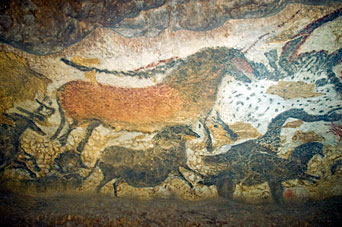
Lascaux cave painting. These paintings are estimated to be 16,000 years old. Photo: Jack Versloot
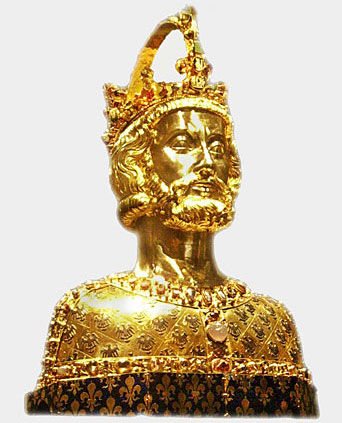
Bust of the Frankish Emperor Charlemagne (Part of the treasure of Aachen Cathedral). Photo: Lokilech
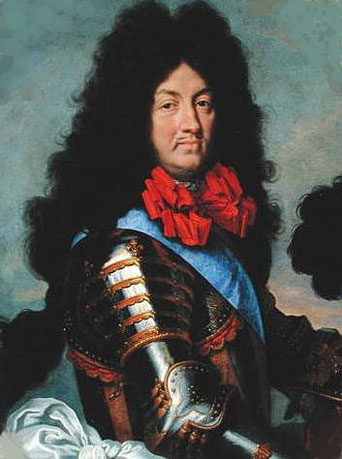
Portrait of Louis XIV of France (1643–1715), the Sun King.
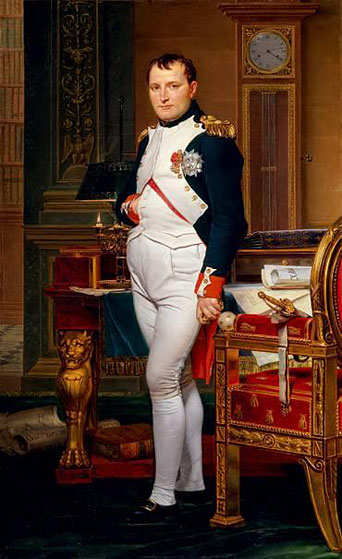
Napoléon Bonaparte (Napoleon I, 1769 – 1821) painting by Jacques-Louis David
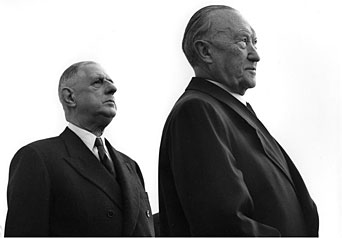
Charles de Gaulle (18th President of the French Republic; l) and Konrad Adenauer (Chancellor of Germany; r)
Photo Source: Deutsches Bundesarchiv (German Federal Archive) |






